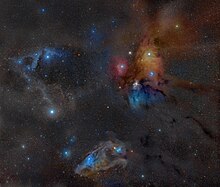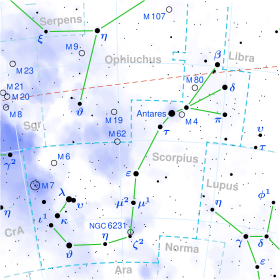Delta Scorpii
Delta Scorpii (Latinised from δ Scorpii, abbreviated Delta Sco, δ Sco) is a binary star (the presence of a third star in the system is being debated[4]) in the constellation of Scorpius. The primary star is named Dschubba /ˈdʒʌbə/.[12][13]
Observation
[edit]
Delta Scorpii is 2.0 degrees south of the ecliptic. It is a binary star with two components of magnitudes 2.4 and 4.6 separated by 0.2″.[16] In 1981 it was occulted by Saturn's rings as seen by Voyager 2, with starlight unexpectedly blocked even by the apparently empty gaps, indicating that "there is very little empty space anywhere in the main ring system."[17]
Variability
[edit]Delta Scorpii A is a Gamma Cassiopeiae variable star. This type of star shows irregular slow brightness variations of a few hundredths of a magnitude due to material surrounding the star.
In June 2000 Delta Scorpii was observed by Sebastian Otero to be 0.1 magnitudes brighter than normal; its brightness has varied since then and has reached at least as high as magnitude 1.6, altering the familiar appearance of Scorpius. Spectra taken after the outburst began have shown that the star is throwing off luminous gases from its equatorial region. The companion passed close by in 2011, again resulting in the star peaking at 1.65 between 5 and 15 July 2011.[4][18]
Nomenclature
[edit]
δ Scorpii (Latinised to Delta Scorpii) is the system's Bayer designation. The two components are designated Delta Scorpii A and B.
Delta Scorpii bore the traditional name Dschubba, which comes from Arabic جبهة العقرب jabhet al-aqrab meaning 'the forehead of the scorpion'. In 2016 the International Astronomical Union organized a Working Group on Star Names (WGSN)[19] to catalogue and standardize proper names for stars. The WGSN approved the name Dschubba for δ Scorpii A on 21 August 2016 and it is now so entered in the IAU Catalog of Star Names.[13]
In Chinese, 房宿 (Fáng Xiù), meaning Room, refers to an asterism consisting of δ Scorpii, β1 Scorpii, β2 Scorpii, π Scorpii, and ρ Scorpii.[20] Consequently, the Chinese name for δ Scorpii itself is 房宿三 (Fáng Xiù sān), "the Third Star of Room".[21]
Properties
[edit]δ Scorpii was once used as a spectroscopic standard for the B0 IV classification, but is now considered too unusual and variable.[4]
The primary, δ Scorpii A, is a B class subgiant surrounded by a disc of material spun off by the rapidly rotating star. The secondary, δ Scorpii B, orbits every 10.5 years in a highly elongated elliptical orbit; it appears to be a normal B class main sequence star. There have been reports that Delta Scorpii A is itself a very close spectroscopic binary, but this does not appear to be the case.[4]
δ Scorpii is a proper motion member of the Upper Scorpius subgroup of the Scorpius–Centaurus OB association, the nearest such co-moving association of massive stars to the Sun.[8][10] The Upper Scorpius subgroup contains thousands of young stars with mean age 11 million years at average distance of 470 light years (145 parsecs).[10]
References
[edit]- ^ a b c d e van Leeuwen, F. (November 2007). "Validation of the new Hipparcos reduction". Astronomy and Astrophysics. 474 (2): 653–664. arXiv:0708.1752. Bibcode:2007A&A...474..653V. doi:10.1051/0004-6361:20078357. S2CID 18759600.
- ^ "Delta Sco". International Variable Star Index. AAVSO. Retrieved 2022-07-29.
- ^ a b Balona, L. A.; Dziembowski, W. A. (October 1999). "Excitation and visibility of high-degree modes in stars". Monthly Notices of the Royal Astronomical Society. 309 (1): 221–232. Bibcode:1999MNRAS.309..221B. doi:10.1046/j.1365-8711.1999.02821.x.
- ^ a b c d e f g h i j k Miroshnichenko, A. S.; Pasechnik, A. V.; Manset, N.; Carciofi, A. C.; Rivinius, Th.; Štefl, S.; Gvaramadze, V. V.; Ribeiro, J.; Fernando, A.; Garrel, T.; Knapen, J. H.; Buil, C.; Heathcote, B.; Pollmann, E.; Mauclaire, B.; Thizy, O.; Martin, J.; Zharikov, S. V.; Okazaki, A. T.; Gandet, T. L.; Eversberg, T.; Reinecke, N. (2013). "THE 2011 PERIASTRON PASSAGE OF THE Be BINARY δ Scorpii". The Astrophysical Journal. 766 (2): 119. arXiv:1302.4021. Bibcode:2013ApJ...766..119M. doi:10.1088/0004-637X/766/2/119. S2CID 38692193.
- ^ a b Gutierrez-Moreno, Adelina; Moreno, Hugo (June 1968). "A photometric investigation of the Scorpio-Centaurus association". Astrophysical Journal Supplement. 15: 459. Bibcode:1968ApJS...15..459G. doi:10.1086/190168.
- ^ Samus, N. N.; Durlevich, O. V.; et al. (2009). "VizieR Online Data Catalog: General Catalogue of Variable Stars (Samus+ 2007–2013)". VizieR On-line Data Catalog: B/GCVS. Originally Published in: 2009yCat....102025S. 1: 02025. Bibcode:2009yCat....102025S.
- ^ Evans, D. S. (June 20–24, 1966). "The Revision of the General Catalogue of Radial Velocities". In Batten, Alan Henry; Heard, John Frederick (eds.). Determination of Radial Velocities and their Applications. IAU Symposium no. 30. Vol. 30. University of Toronto: International Astronomical Union. p. 57. Bibcode:1967IAUS...30...57E.
- ^ a b c de Geus, E. J.; de Zeeuw, P. T.; Lub, J. (June 1989). "Physical parameters of stars in the Scorpio-Centaurus OB association". Astronomy and Astrophysics. 216 (1–2): 44–61. Bibcode:1989A&A...216...44D.
- ^ a b Meilland, A.; et al. (August 2011). "The binary Be star δ Scorpii at high spectral and spatial resolution. I. Disk geometry and kinematics before the 2011 periastron". Astronomy & Astrophysics. 532: A80. arXiv:1106.1746. Bibcode:2011A&A...532A..80M. doi:10.1051/0004-6361/201116798. S2CID 118501743.
- ^ a b c d e Mark J. Pecaut; Eric E. Mamajek & Eric J. Bubar (February 2012). "A Revised Age for Upper Scorpius and the Star Formation History among the F-type Members of the Scorpius-Centaurus OB Association". Astrophysical Journal. 746 (2): 154. arXiv:1112.1695. Bibcode:2012ApJ...746..154P. doi:10.1088/0004-637X/746/2/154. S2CID 118461108.
- ^ a b c Moore, Patrick (2010). "Scorpion in the Sky". The Sky at Night. pp. 95–98. doi:10.1007/978-1-4419-6409-0_24. ISBN 978-1-4419-6408-3.
- ^ Kunitzsch, Paul; Smart, Tim (2006). A Dictionary of Modern star Names: A Short Guide to 254 Star Names and Their Derivations (2nd rev. ed.). Cambridge, Massachusetts: Sky Pub. ISBN 978-1-931559-44-7.
- ^ a b "IAU Catalog of Star Names". Retrieved 28 July 2016.
- ^ Suffak, M. W.; Jones, C. E.; Tycner, C.; Henry, G. W/; Carciofi, A. C.; Mota, B. C.; Rubio, A. C. (February 2020). "The Large-scale Behavior in the Disk of δ Scorpii from 2000 to 2018". The Astrophysical Journal. 890 (1): 86. arXiv:2001.04966. Bibcode:2020ApJ...890...86S. doi:10.3847/1538-4357/ab68dc. S2CID 210473366.
- ^ Miroshnichenko, A. S.; Fabregat, J.; Bjorkman, K. S.; Knauth, D. C.; Morrison, N. D.; Tarasov, A. E.; Reig, P.; Negueruela, I.; Blay, P. (October 2001). "Spectroscopic observations of the δ Scorpii binary during its recent periastron passage" (PDF). Astronomy and Astrophysics. 377 (2): 485–495. arXiv:astro-ph/0106492. Bibcode:2001A&A...377..485M. doi:10.1051/0004-6361:20010911. S2CID 14372764. Retrieved 29 July 2022.
- ^ Mason, B. D.; et al. (2014). "The Washington Visual Double Star Catalog". The Astronomical Journal. 122 (6): 3466–3471. Bibcode:2001AJ....122.3466M. doi:10.1086/323920.
- ^ Moore, Patrick (2000). The Data Book of Astronomy. CRC Press. ISBN 9781420033441.
- ^ Sigismondi, Costantino (2011), Differential photometry of delta Scorpii during 2011 periastron, vol. 1112, p. 2356, arXiv:1112.2356, Bibcode:2011arXiv1112.2356S
- ^ IAU Working Group on Star Names (WGSN), International Astronomical Union, retrieved 22 May 2016.
- ^ (in Chinese) 中國星座神話, written by 陳久金. Published by 台灣書房出版有限公司, 2005, ISBN 978-986-7332-25-7.
- ^ (in Chinese) 香港太空館 - 研究資源 - 亮星中英對照表 Archived 2008-10-25 at the Wayback Machine, Hong Kong Space Museum. Accessed on line November 23, 2010.
External links
[edit]- Jim Kaler's Stars, University of Illinois: Dschubba
- Delta Scorpii brighter than ever (Sky and Telescope, February 4, 2002)
- Delta Scorpii still showing off (Sky and Telescope, June 25, 2003)
- Delta Scorpii: the birth of a Be star (AAVSO article)
- Pages using the JsonConfig extension
- Scorpius
- Bayer objects
- B-type subgiants
- Stars with proper names
- Upper Scorpius
- B-type main-sequence stars
- Binary stars
- Gamma Cassiopeiae variable stars
- Be stars
- Durchmusterung objects
- Bright Star Catalogue objects
- Hipparcos objects
- Henry Draper Catalogue objects
- Flamsteed objects

